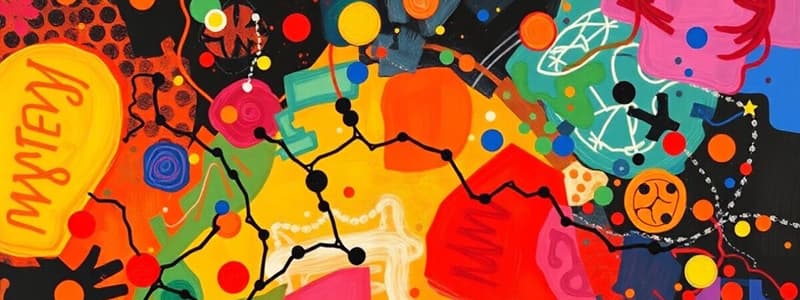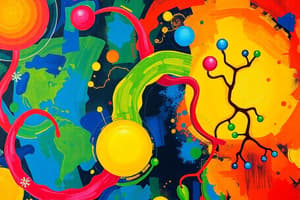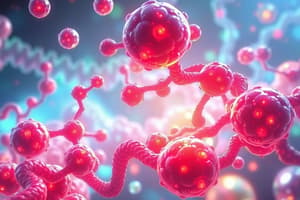Podcast
Questions and Answers
What is the primary physiological role of serotonin in the body?
What is the primary physiological role of serotonin in the body?
- Reducing allergic reactions
- Enhancing glucose metabolism
- Stimulating muscle contraction
- Regulating blood pressure (correct)
Which step is considered the rate-limiting step in the biosynthesis of catecholamines?
Which step is considered the rate-limiting step in the biosynthesis of catecholamines?
- Formation of norepinephrine
- Synthesis of serotonin
- Degradation of dopamine
- Conversion of tyrosine to DOPA (correct)
How are catecholamines inactivated in the body?
How are catecholamines inactivated in the body?
- Through enzymatic hydrolysis only
- By oxidative deamination and O-methylation (correct)
- By hydrolysis in the liver
- Via renal excretion alone
Mast cells secrete histamine in response to what type of biological event?
Mast cells secrete histamine in response to what type of biological event?
Which of the following is a biological amine that acts as both a neurotransmitter and a regulator of blood pressure?
Which of the following is a biological amine that acts as both a neurotransmitter and a regulator of blood pressure?
What increases the solubility of bilirubin in hepatocytes?
What increases the solubility of bilirubin in hepatocytes?
Which type of jaundice is caused by bile duct obstruction?
Which type of jaundice is caused by bile duct obstruction?
What is the role of creatine kinase during intense muscular contraction?
What is the role of creatine kinase during intense muscular contraction?
What is formed when bilirubin diglucuronide is hydrolyzed and reduced by gut bacteria?
What is formed when bilirubin diglucuronide is hydrolyzed and reduced by gut bacteria?
Which condition does not cause high levels of bilirubin leading to jaundice?
Which condition does not cause high levels of bilirubin leading to jaundice?
What does creatinine level in urine indicate?
What does creatinine level in urine indicate?
Histamine plays a role in which of the following processes?
Histamine plays a role in which of the following processes?
What is the ultimate product formed from the spontaneous degradation of creatine?
What is the ultimate product formed from the spontaneous degradation of creatine?
Which enzyme catalyzes the formation of δ-amino levulinic acid (ALA) in porphyrin biosynthesis?
Which enzyme catalyzes the formation of δ-amino levulinic acid (ALA) in porphyrin biosynthesis?
What is the primary site of heme biosynthesis?
What is the primary site of heme biosynthesis?
Which compound serves as a precursor for the formation of porphyrins?
Which compound serves as a precursor for the formation of porphyrins?
What product is formed when two molecules of ALA condense during porphyrin biosynthesis?
What product is formed when two molecules of ALA condense during porphyrin biosynthesis?
During heme degradation, what is the initial product formed from heme before bilirubin is produced?
During heme degradation, what is the initial product formed from heme before bilirubin is produced?
Which metal ion is coordinated in the center of porphyrins?
Which metal ion is coordinated in the center of porphyrins?
What is the function of the enzyme heme oxygenase in heme degradation?
What is the function of the enzyme heme oxygenase in heme degradation?
Which statement about the properties of heme is correct?
Which statement about the properties of heme is correct?
Flashcards
Porphyrins
Porphyrins
A cyclic compound that binds metal ions, usually Fe+2 or Fe+3, and is the basis of heme.
Heme
Heme
A prosthetic group for proteins like hemoglobin, myoglobin, cytochromes, catalase, and tryptophan pyrrolase, containing a ferrous ion coordinated in the center of a porphyrin ring.
ALA Synthase
ALA Synthase
The rate-limiting step in porphyrin synthesis, converting glycine and succinyl CoA into δ-aminolevulinic acid (ALA).
Porphobilinogen
Porphobilinogen
Signup and view all the flashcards
Uroporphyrinogen formation
Uroporphyrinogen formation
Signup and view all the flashcards
Heme degradation
Heme degradation
Signup and view all the flashcards
Biliverdin
Biliverdin
Signup and view all the flashcards
Bilirubin
Bilirubin
Signup and view all the flashcards
Histamine
Histamine
Signup and view all the flashcards
Serotonin
Serotonin
Signup and view all the flashcards
Catecholamines
Catecholamines
Signup and view all the flashcards
Tyrosine Hydroxylase
Tyrosine Hydroxylase
Signup and view all the flashcards
Melanin
Melanin
Signup and view all the flashcards
Creatine Phosphate
Creatine Phosphate
Signup and view all the flashcards
Creatine Kinase
Creatine Kinase
Signup and view all the flashcards
Creatinine
Creatinine
Signup and view all the flashcards
Active Transport
Active Transport
Signup and view all the flashcards
Jaundice
Jaundice
Signup and view all the flashcards
Study Notes
Nitrogen Metabolism
- Nitrogen is disposed of via the urea cycle.
- The carbon skeleton is catabolized.
- Nitrogen-containing substances include:
- Porphyrins (heme)
- Creatine
- Histamine
- Serotonin
- Catecholamines
- Melanin
Porphyrins
- Porphyrins are cyclic compounds that bind metal ions, usually Fe2+ or Fe3+.
- Metaloporphyrins in humans are primarily heme—a prosthetic group in hemoglobin, myoglobin, cytochromes, catalase, and tryptophan pyrrolase.
- Heme is a ferrous ion coordinated in the centre of porphyrins.
- Heme is synthesized and destroyed at a rate of 6-7 grams daily.
- Porphyrin structure is composed of four pyrrole rings linked by methylene bridges.
- Different types of porphyrins (I, II, III, IV) vary in their side chains attached to the pyrrole rings.
- Different side chains lead to different porphyrins, including uroporphyrin I and uroporphyrin III
Porphyrin Biosynthesis
- The major site of heme biosynthesis is the liver, with the initial and final steps occurring in mitochondria and other reactions taking place in the cytosol.
- The formation of 8⁻aminolevulinic acid (ALA) is a critical, rate-limiting step in heme synthesis, catalyzed by ALA synthase.
- ALA synthase is inhibited by heme.
- Two molecules of ALA condense to form porphobilinogen via amino levulinic acid dehydrase.
- Subsequent reactions lead to the formation of uroporphyrinogen.
- Uroporphyrinogen III is converted to heme via a series of decarboxylation processes.
Hemoglobin
- Hemoglobin, a protein, contains heme prosthetic groups
- The diagram shows the structure of hemoglobin with hemes highlighted.
Heme Degradation
- The lifespan of red blood cells (RBCs) is 120 days.
- RBCs are taken up by the liver, spleen, and macrophages of the reticuloendothelial system (RE).
- The breakdown of heme begins with the action of heme oxygenase.
- The first step in the degradation involves the conversion of heme to biliverdin, catalyzed by heme oxygenase.
- Biliverdin is reduced to bilirubin.
- Bilirubin is transported in the blood bound to albumin.
- When bilirubin reaches the liver, it is conjugated with glucuronic acid to increase its water solubility.
- Conjugated bilirubin is secreted into bile.
- In the intestines Bilirubin diglucuronide is hydrolyzed and reduced to yield urobilinogen.
- Some urobilinogen is reabsorbed and goes to the kidneys where it is converted to either urobilin and/or stercobilin.
- Stercobilin is responsible for the brown color of feces.
- Urobilin gives urine its yellow color.
Bilirubin Uptake and Formation of Bilirubin Diglucuronide
- Bilirubin is taken up by the liver and conjugated with glucuronic acid.
- Conjugation increases the water solubility of bilirubin.
- The resulting bilirubin diglucuronide is secreted in bile
Creatine
- Creatine phosphate is a high-energy compound found in muscle.
- It can reversibly donate a phosphate group to ADP, creating ATP during intense muscle contraction.
- Creatine kinase activity in the blood is used to diagnose myocardial infarction.
- Creatine is synthesized from glycine, the guanidino group of arginine, and a methyl group.
Creatine Degradation
- Creatine and phosphocreatine spontaneously cyclize slowly to create creatinine.
- Creatinine is excreted in the urine.
- Creatinine levels in urine are proportional to creatine levels in the blood plasma.
- Creatinine levels can be used as an indicator of total body muscle mass and kidney function.
Histamine
- Histamine is a chemical messenger involved in allergic reactions, inflammation, and neurotransmission.
- Histamine is formed from the decarboxylation of histidine.
- Histamine is secreted by mast cells during allergic reactions.
Serotonin
- Serotonin is synthesized from tryptophan.
- Serotonin is produced and stored in the small intestine, platelets, and the CNS.
- It plays a role in pain, blood pressure, body temperature, and sleep regulation.
Catecholamines
- Catecholamines (dopamine, epinephrine, norepinephrine) are biologically active amines that function as neurotransmitters in the brain and CNS.
- They are associated with the "fight-or-flight" response.
- Nor-epinephrine and epinephrine are synthesized in the adrenal medulla.
- Catecholamines are degraded by enzymatic processes.
Melanin
- Melanin is a pigment found in tissues like skin, hair, and eyes.
- Melanocytes produce melanin to protect against UV light.
Studying That Suits You
Use AI to generate personalized quizzes and flashcards to suit your learning preferences.




